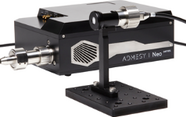
The Analytical Scientist Innovation Awards 2018: Strokes of Genius
From game-changing GC to simpler sampling to a rise in automated analytical technology, the 2018 TASIAs paint a vibrant picture of the future.
1. HYPERCHROM FLOW-FIELD THERMAL GRADIENT GC
Hyper-fast GC with cycle times of less than 60 seconds
Produced by HyperChrom
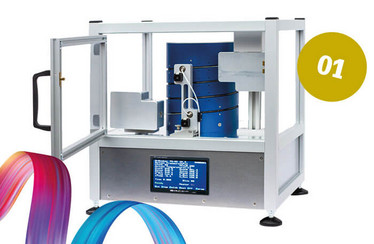
The HyperChrom FF-TG-GC is a hyper-fast GC based on a new principle: flow-field thermal gradient gas chromatography. For the first time, an additional spatial thermal gradient is applied along the column in a commercial GC. In combination with temperature programming, a new mode of chromatographic transport and separation takes place. The benefits of this gradient elution are lower elution temperatures and an enhanced resolution.
The newly launched system is a fully featured GC and comprises many advanced technologies: standard separation columns can be utilized and changed easily; purged connectors avoid dead volume effects and enable back-flushing of the injector and the column. Real-time electronic control synchronizes high precision temperature and pressure ramps and the event control for valves on a milliseconds scale. The employment of all these technologies leads to remarkable chromatographic resolution and stability.
Potential impact
The FF-TG-GC is a high-throughput GC measurement system, with fast heating rates and cool down times; the system cools down from 400°C to 30°C within 10 seconds, allowing laboratories to achieve much higher sample throughput rates. In certain applications, a single FF-TG-GC could replace at least 10 conventional GC systems, including peripheral instrumentation (for example, samplers), saving investment, labor, energy and consumables.
The high measurement speed provides fast analytical results; in industrial processes, it means results being collected in near real time with the analytical accuracy of classic GC-MS systems. Such speed is also an advantage in security applications where fast results (for example, the detection of explosives or drugs) or many measurements in a short time are required.
Despite the level of performance already achieved, the development of the technology is still in its infancy. Simulation-based improvements are in progress, as is the refinement of many embedded technologies. With the two-dimensional extension of the HyperChrom GC an even higher resolution with short cycle times will be available.
2. THERMO SCIENTIFIC PHENOM PHAROS DESKTOP SCANNING ELECTRON MICROSCOPE (SEM)
The first desktop SEM with a field emission gun (FE
Produced by Thermo Fisher Scientific
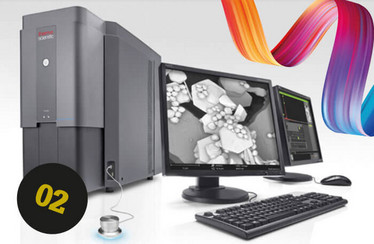
The Thermo Scientific Phenom Pharos desktop scanning electron microscope (SEM) is the first desktop SEM solution from the company that includes a field emission gun (FEG). The Phenom Pharos microscope is easy to operate and incorporates an advanced hardware design for fast time-to-image and simple handling. A wide range of academic and industrial researchers now have access to the benefits of FEG in a desktop model, which can increase their throughput and result in high-quality images and resolution. In addition to providing advanced detectors that can acquire high-quality images with magnifications of up to one million times, the Phenom Pharos microscope also offers researchers:
- access to sharp, high-contrast images with resolutions below three nanometers;
- an intuitive user interface that enables researchers to get a live image in less than 25 seconds after inserting the sample;
- high-resolution imaging that can be obtained simultaneously with analytical techniques.
Potential impact
In the past, only highly-experienced scientists have been able to operate and benefit from FEG- equipped scanning electron microscopes (SEM), but Phenom Pharos brings the benefits of FEG to users with different experience levels; it is easy to use, and installation can be done without the need for special room requirements. Installation is fully automated and once initialized, the user interface enables researchers, students and operators alike to analyze images and corresponding details at the nanoscale, from visualizing multiwall carbon nanotubes to capturing high-resolution imaging of Ag nanoparticles.
Find out more...
3. THERMO SCIENTIFIC ORBITRAP ID-X TRIBRID MASS SPECTROMETER SYSTEM
A mass spectrometry system with the potential to transform small molecule characterization
Produced by Thermo Fisher Scientific
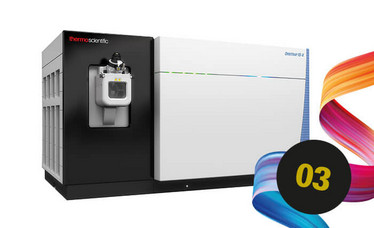
The Thermo Scientific Orbitrap ID-X Tribrid Mass Spectrometer system combines quadrupole, Orbitrap and linear ion trap mass analyzer technology with novel automated data acquisition strategies and powerful structural analysis software processing tools. The combination provides a complete solution – from data acquisition to data analysis – and aims to significantly improve and accelerate the identification and characterization of small molecule compounds. Proven Thermo Scientific Tribrid architecture, the AcquireX data acquisition tool, method editor templates and ready-to-use experimental parameters ensure efficient acquisition of high-quality data, even for non-expert users. Coupled with the mzLogic data analysis algorithm, a powerful online spectral library (mzCloud) and data processing software solutions (Compound Discoverer and Mass Frontier), the Orbitrap ID-X Tribrid mass spectrometer provides a serious solution for small molecule structural analysis, significantly increasing accuracy, efficiency, and overall productivity in drug impurity and metabolite identification, extractable and leachable analysis, and other related applications.
Potential impact
Interpreting the mass spectra of unknown compounds remains challenging and is a frequent bottleneck in many fields, including food safety, environmental monitoring and pharma/biopharma. The Thermo Scientific Orbitrap ID-X Tribrid Mass Spectrometer offers a complete, intelligent solution that accelerates small molecule identification and characterization by automatically capturing the maximum possible information about small molecules and translating it into confident identification of chemical compounds. By enabling the collection of a greater amount of structure-informative data, the system increases the depth of small molecule compound analysis for better structural characterization. The system brings greater confidence to the analysis and identification of degradants, extractables, leachables, metabolites and other classes of compounds, and aids in metabolomics, lipidomics and the study of natural products.
4. THERMO SCIENTIFIC Q EXACTIVE UHMR HYBRID QUADRUPOLE-ORBITRAP MASS SPECTROMETER
A unique mass spectrometry platform that aims to expand our understanding of proteins
Produced by Thermo Fisher Scientific
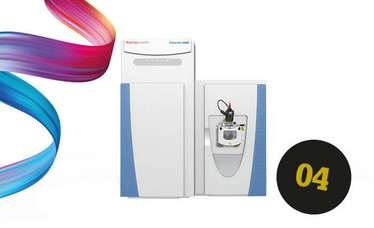
The Thermo Scientific Q Exactive UHMR Hybrid Quadrupole-Orbitrap Mass Spectrometer is the first ultra-high mass range (UHMR) mass spectrometer (MS) to combine high m/z (mass to charge), MS2, and pseudo-MS3 capabilities in a single platform. Delivering high sensitivity that minimizes sample volume, and ultra-high mass resolution at up to 80,000 m/z, the system is designed to resolve the small differences in masses required to characterize intact biomolecular assemblies and other large molecule complexes. Ultra-high mass quadrupole selection and higher fragmentation efficiency allow improved native top-down analysis, which provides structural detail that cannot be seen with other methods. By varying the in-source trapping energy, the instrument can release protein subunits for top-down sequencing or, with gentle activation, retain membrane proteins bound to multiple ligands, allowing whole complex analysis. The Q Exactive UHMR Hybrid Quadrupole-Orbitrap Mass Spectrometer is designed to unlock a greater understanding of proteins and their interactions.
Potential impact
Native mass spectrometry is a powerful technique for studying the structure of large protein complexes, protein–protein, and protein–ligand interactions. It relies on maintaining a biomolecule’s natural folded state and associated non-covalent interactions for MS analysis. Until now, technology limitations have prevented native MS from achieving its full potential. The Q Exactive UHMR Hybrid Quadrupole-Orbitrap Mass Spectrometer provides the unique combination of unprecedented resolution, highest sensitivity, MS2 and pseudo-MS3 capabilities needed to advance native MS investigations, overcoming previous technology limitations and providing a workflow for protein structural analysis. Albert Heck, Biomolecular Mass Spectrometry and Proteomics, University of Utrecht, used it to achieve “high-fidelity, hypothesis-free mass analysis of intact ribosome particles, revealing the substoichiometric association of even elusive small particles.” The new system should give researchers the tool they need to gain a deeper understanding of protein function, disease mechanisms, potential drug targets and biotherapeutic compounds and advance the study of structural biology.
Find out more...
5. TOUCH EXPRESS OPEN PORT SAMPLING INTERFACE (OPSI)
A one touch sampling technique for solids, liquids, sample preparation tips, and fibers
Produced by Advion
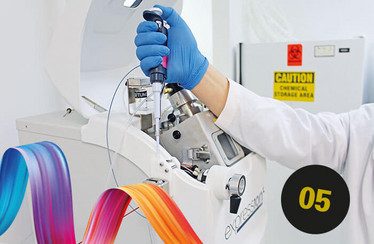
The novel Touch Express Open Port Sampling Interface (OPSI) ambient sampling technique was developed by Gary Van Berkel and Vilmos Kertesz, of Oak Ridge National Laboratory. The Touch Express OPSI incorporates a low-volume, open port of continuously swept solvent, which flows directly into the electrospray ion source of the Advion expression Compact Mass Spectrometer.
Potential impact
The OPSI source is a unique, prep-free sample technique that offers i) compound identification and impurity detection from almost any surface, ii) direct assays from sample preparation tips and SPME fibers, iii) easy screening applications for drug research, food safety, environmental, and forensics, and iv) large molecule applications, including proteins, peptides, oligonucleotides and polymers.
6. AGILENT 8700 LASER DIRECT INFRARED (LDIR) CHEMICAL IMAGING SYSTEM
An innovative, easy-to-use infrared system that allows fast, high-quality chemical imaging
Produced by Agilent Technologies
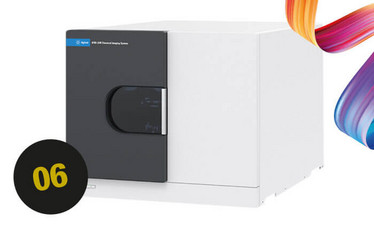
The Agilent 8700 Laser Direct Infrared (LDIR) chemical imaging system is the newest instrument in Agilent’s infrared spectroscopy portfolio and represents a new approach to chemical imaging and spectral analysis.
Using a Quantum Cascade Laser, the 8700 LDIR directs light over the sample to create a complete molecular map of the sample by analyzing the specific wavelengths of infrared light absorbed and then comparing the structure-specific signature to a reference database.
Designed to be used by experts and non-experts alike, the Agilent 8700 LDIR provides a simple, low-maintenance and highly automated approach for obtaining reliable, high-definition chemical images of constituents on a surface.
Potential impact
The Agilent 8700 LDIR offers rapid processing, building chemical images over large areas in less than 30 minutes, which could save labs both time and money. Imaging itself, which is fully controlled by the Agilent Clarity software, is an entirely automated process, taking the usual spectroscopy chores out of the hands of the operator, with a subsequent increase in the accuracy of results. Indeed, novice operators are able to run experiments from day one.
The Agilent 8700 LDIR does not use liquid nitrogen cooling but instead employs a single-element electrically cooled detector, which not only eliminates laser coherence artifacts that can reduce the quality and reliability of images, but also minimizes the need for maintenance.
Finally, the Agilent 8700 LDIR fits all of the above qualities into a reduced footprint, freeing up valuable lab space.
7. MICROSAIC PROTEINID
Point-of-need mass spectrometry to accurately identify proteins
Produced by Microsaic Systems
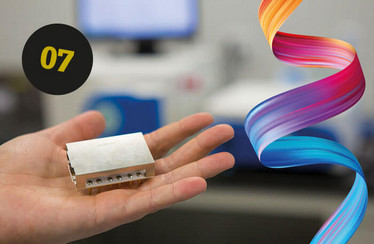
The Microsaic ProteinID is a mass identification technique that allows users to characterize proteins and small molecules at the point of need, throughout the whole bioprocessing value chain – from cell train and bioreactor, to capture and fill. The Microsaic ProteinID offers fast results over a mass range of 50-3,200 m/z, the broadest mass coverage for a small footprint mass spectrometer. And unlike other contemporary “compact” mass spectrometers, the Microsaic ProteinID offers laboratory-level performance on an industrial scale, but without large, noisy floor pumps or exhausts.
Potential impact
Bringing the power of the centralized laboratory to in-situ bioprocessing line measurements, the Microsaic ProteinID simultaneously analyzes the product and matrix parameters used to control upstream and downstream bioprocessing, either on-line or at-line, with the aim of reducing key bioprocessing analyses from days to minutes. With the Microsaic Protein ID, operators can monitor feedstocks, metabolites and target proteins in one measurement, potentially accelerating time-to-market for new biologics development, while also enhancing QbD capabilities and improving compliance with regulatory demands for CQA in biologics during pilot and full-scale manufacture. Mass spectrometry can now offer superlative performance to high-value manufacturing industries at the point-of-need, providing greater insights over ubiquitous optical sensors, such as UV, Raman, and NIR.
8. THERMO SCIENTIFIC COMPOUND DISCOVERER 3.0 SOFTWARE
Easy-to-use software that advances small molecule analysis
Produced by Thermo Fisher Scientific

The Thermo Scientific Compound Discoverer is an integrated set of databases, statistical analysis tools and online libraries (mzCloud) that streamlines and customizes high-resolution accurate-mass (HRAM) data analysis. Full-scan mass spectrometry generates large amounts of information in small molecule applications, often making efficient data processing and the confident extraction of real insight challenging. Compound Discoverer software processes the information-rich data from high-resolution accurate mass (HRAM) Thermo Scientific Orbitrap mass spectrometers and transforms it into meaningful results. This easy-to-use software simplifies and reduces processing clicks, enabling faster, more confident transition from analysis to insight. Customizable node-based workflows, integrated compound identification capabilities and statistical analysis all reduce the time involved in using multiple software tools to analyze results.
Potential impact
Compound Discoverer offers scientists working in metabolomics, pharmaceuticals, food safety, environmental and forensic applications the opportunity to more easily transform complex, unknown mass spectra generated from small molecule analysis into actionable data. This integrated toolkit is designed to require minimal training and expertise – making it straightforward to use – however, highly customizable workflows offer the flexibility to match individual analysis requirements. Juan Moises Sanchez, associate scientist, bioanalytical chemistry at Intrexon, said, “Implementation of this software has reduced our bioinformatics lead time and improved the impact of our research in the areas of high-throughput untargeted metabolomics, structural elucidation of unknowns and carbon fate studies.”
9. CEU MASS MEDIATOR
Software for metabolite annotation in untargeted metabolomics
Produced by CEMBIO
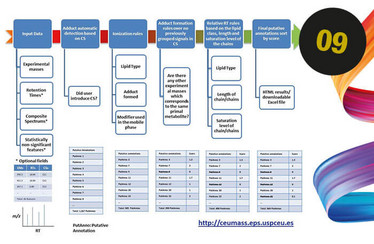
CEU Mass Mediator (CMM) is an on-line software tool developed at the Centre for Metabolomics and Bioanalysis (CEMBIO) that allows researchers to filter and score the putative annotations for MS-based metabolomics studies, with the aim of saving time and reducing misidentifications. It uses a knowledge-based system with rules related to: i) the propensity to form certain types of adducts depending on the metabolite type; ii) the relation between different signals coming from the same experiment and iii) the retention time of the metabolites in the separation column. CEMBIO believes that CMM is the first tool to use a knowledge-driven approach to support metabolite annotation.
Built on J2EE technologies, CMM performs searches using HMDB, KEGG, LipidMaps, Metlin, and MINE databases, as well as an in-house library. Furthermore, the compounds from these databases have been unified whenever possible, avoiding repeated compounds among the results.
Potential impact
Metabolite identification is the main bottleneck in untargeted metabolomics studies; annotation is the first step of the identification. The task is cumbersome, time-consuming and prone to errors. The number of putative identifications for one single mass is very high, and increases along with the number of compounds present in databases. Many researchers use Excel files to handle metabolite annotation, integrating the results from several databases, and then applying their own biochemistry knowledge to manually discard or retain them.
Using a single interface, CMM offers automation of these tasks – even the steps guided by biochemistry knowledge – and it is freely available on-line. Furthermore, it supports identification of oxidized lipids from MS/MS information and provides a system for calculating the quality of MS/MS spectra for identification purposes. Such services enable the user to speed up and improve the identification of metabolites.
Find out more...
10. CENTRI
An automated multi-mode sampling and concentration system for GC-MS
Produced by Markes International
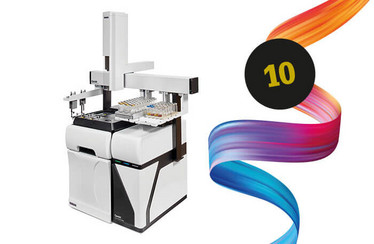
Centri offers versatility and performance in the sampling and preconcentration of volatile and semi-volatile organic compounds from solid, liquid and gaseous samples, prior to GC-MS analysis. Centri combines several popular sample introduction modes – with full automation and trap-based preconcentration in a single platform: i) headspace or immersive high-capacity sorptive extraction using HiSorb™ probes; ii) headspace sampling; iii) solid-phase microextraction (SPME); iv) analysis of sorbent-packed thermal desorption (TD) tubes. The system can accommodate standard 20 mL or 10 mL vials, has capacity for up to 50 TD tubes, and is automated by leading robotics technology, with the full automation of high-capacity sorptive extraction being a significant instrumental advance.
Potential impact
Centri could benefit environmental, food, fragrance and clinical GC-MS laboratories that struggle with time-consuming manual sample preparation, and want to improve productivity through the introduction of automated solvent-free methods. Further benefits are provided by the availability of economical cryogen-free trapping – a standard technique for TD and sorptive extraction protocols, but one that is used less often for SPME and headspace sampling. Trapping improves sensitivity to the ppt level, allows selective purging of interferents, such as water and solvents, and offers the ability to split and recollect a single sample onto a clean sorbent-packed tube; the re-collection capability of Centri is particularly important, because it eliminates repetition of lengthy sample extraction steps, brings greater peace of mind by allowing storage of valuable samples, enables analysis of a wider concentration range by changing split flow ratios, and permits easy validation of complete analyte transfer.
11. OCEAN MZ5 ATR-MIR SPECTROMETER
A self-contained, economical alternative to traditional FTIR spectroscopy
Produced by Ocean Optics
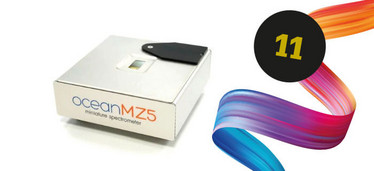
The Ocean MZ5 is a miniature ATR spectrometer with measurement capabilities from 1818-909 cm-1 (5.5-11 µm). This fully self-contained instrument – including sample interface, light sources and detector – provides a compact, fast and scalable alternative to traditional FTIR spectroscopy. Applications include chemical discrimination, food and flavorings analysis, environmental testing and scientific research.
Ocean MZ5 works straight out of the box and does not require any external equipment, such as a light sources or fibers. Ocean Mirror, the software that comes with the system, is designed for measuring absorbance and transmittance of liquids placed on the instrument’s crystal surface.
Potential impact
With the counterfeiting of goods from foods to fuels now a global problem, the task of authenticating materials, such as biodiesel, essential oils and dairy products, demands robust, simple-to-use tools based on sound science.
Mid-infrared spectroscopy is especially useful for identifying adulterants, which often have well defined absorption characteristics within the IR fingerprint region. The Ocean MZ5 ATR-MIR spectrometer, which measures liquids, is more compact, more portable and simpler to use for screening than alternative technologies, such as gas chromatography, mass spectrometry and FTIR spectroscopy.
By bringing the instrument to the sample, the Ocean MZ5 can offer screening throughout the supply chain. For example, screening milk for quality and adulterants at remote collection centers could save thousands of dollars by discovering adulterated milk early in the food chain instead of during the dairy production stage.
12. AQS3PRO
Protein characterization through five measurements: aggregation, quantification, stability, structure and similarity
Produced by RedShiftBio
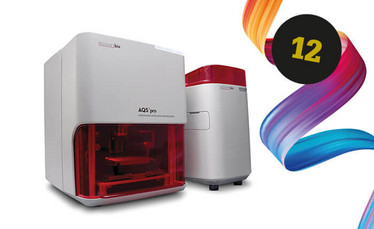
Microfluidic modulation spectroscopy (MMS) is a proprietary technology that directly addresses the limitations of current technologies and provides an efficient tool for direct, label-free protein analysis.
The AQS3pro is built on MMS technology. With its greater sensitivity, the AQS3pro now makes it possible to characterize proteins from 0.1 mg/mL to over 200 mg/mL, the concentration range found across the full spectrum of drug development. No other similarly capable technique, including FTIR, circular dichroism and differential scanning calorimetry, is capable of this range of analysis, and so the AQS3pro enables scientist to see changes that they might currently miss. As a flow technology with built-in real time referencing, MMS instruments can also be automated. The AQS3pro is a true walk-away instrument, capable of running through well plates automatically to provide characterization of aggregation, quantitation, similarity, stability and biophysical structure.
Potential impact
As protein structure directly impacts drug efficacy and safety, protein chemists and formulators rely heavily on structural characterization techniques to develop stable, commercially viable products. When multiple instruments have to be used at different stages of the drug development pipeline, it is both inefficient (raising development costs) and far more challenging to make comparative measurements. The ability to conduct five measurements using a single instrument – with a high degree of automation, high sensitivity and wide concentration range – could help solve these problems for the protein scientist and result in a more efficient and accurate drug development process.
13. THERMO SCIENTIFIC FAIMS PRO INTERFACE
A differential ion mobility interface that boosts proteomics workflow performance
Produced by Thermo Fisher Scientific
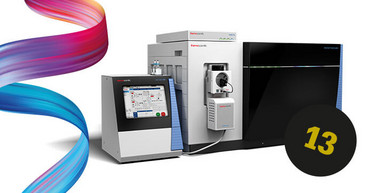
The Thermo Scientific FAIMS Pro interface is a next-generation differential ion mobility device that provides the selectivity and ease-of-use needed for the most demanding analytical challenges in proteomics. Identifying and characterizing proteins and post-translational modifications through bottomup mass spectrometry relies on the acquisition of high-quality MS and MS/MS data. The FAIMS Pro interface increases analytical performance through gas phase fractionation and selective enhancement of peptidic compounds, reducing the complexity of the MS spectra and improving analyte signal/ noise ratio. When integrated with an Orbitrap Tribrid MS system, it further increases the breadth and depth of protein and peptide identification. Menu-driven software enables method design using pre-configured parameters, increasing productivity and simplifying use, while reduced sample fractionation saves time and costs. Designed to improve nano, capillary and microflow applications, the interface achieves high data quality on even sample-limited studies, delivering selectivity and productivity in high-resolution MS across proteomics applications.
Potential impact
Today, there is increasing demand for improved protein coverage during proteomics experiments, greater dynamic range to comprehensively characterize and validate proteins and their post-translational modifications, and more accurate quantitation of many thousands of proteins in a single run with shorter analysis times. The FAIMS Pro interface is expected to reduce sample and spectral complexity, improve selectivity and increase coverage of the proteome, delivering greater productivity across a range of proteomics workflows. One early user reported, “FAIMS Pro enables considerably more sample depth per unit time and could eliminate the need for pre-fractionation of peptides for most applications.”
14. ARC-I CATALYTIC COMBUSTION REACTORS
Developed for the measurement of carbon isotope ratios of steroids and alkanes
Produced by Dell Medical School
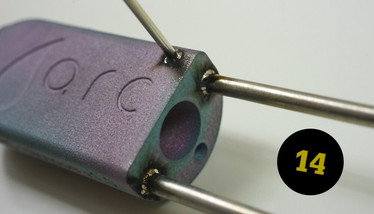
ARC-i (ARC-isotope) reactors were developed and characterized for carbon isotope ratio (CIR) analysis of steroids and alkanes, using gas chromatography combustion isotope ratio mass spectrometry (GCC-IRMS) for detection of synthetic steroid use in doping control and measurement of alkanes of interest in geology and the petroleum industry. Specifically, the reactors were custom designed to operate with combustion volumes consisting of a transition-metal catalyst to enable – for the first time – complete combustion of organics to CO2 molecules at dramatically lower temperatures (620°C) than fragile metal oxide-filled reactors, which operate at ~950°C, constructed with ceramic tubes widely used for GCC-IRMS. With ARC-I, the 13C/12C isotope ratio can be measured with high precision.
Potential impact
Carbon isotope ratio (CIR) analysis is used for the detection of testosterone and other endogenous steroids in “doping” applications, as well as in geochemical and petrochemical laboratories. Quantitative combustion of organic analytes to CO2 is required prior to admission to the IRMS. Since their introduction in the late 1980s, the high temperature furnaces used in all commercial systems have been a huge barrier to further innovation because of the limited range of materials available at 950°C. Availability of lower temperature combustion overcomes the major technical hurdle to implementation of high performance methods to deliver faster and better sensitivity for CIR doping laboratory analysis. The novel ARC-i reactor employs an oxidation catalyst that delivers complete combustion of steroids and other organic compounds at temperatures 300°C lower than previously achieved. The commercially engineered system is easily integrated into existing analysis systems and initial tests show the reactors to be as robust as commercially available equipment. In addition to providing a new modular solution for laboratories, it represents a proof-of-principle that encourages future refinements to further lower combustion reactor temperatures.
Characterized at Dell Medical U Texas for the isotope measurements.
15. “IONI” API-TOF
An atmospheric pressure interface for the modular ioniTOF platform
Produced by IONICON

All IONICON’s PTR-TOFMS series products are based on the ioniTOF – a modular and flexible, entry-level to highresolution time-of-flight mass spectrometer platform, featuring custom interfaces and high-performance IONICON hexapole ION-GUIDEs. IONICON has now taken the concept one step further and developed an atmospheric pressure interface for the ioniTOF. The APi-TOF consists of a critical orifice for contact free sample introduction, two hexapole ION-GUIDEs for high ion transmission efficiency over a broad m/z range, and a high performance pump for high sample throughput. The interface is coupled to an orthogonal TOF analyzer equipped with an ion mirror for increased mass resolution. One advantage of the IONICON hexapole IONGUIDE over conventional quadrupole interfaces is that the energy in the multipole is lower, which decreases unwanted ion-chemistry artifacts. Another advantage is that the massrange transmitted through the multipole is much broader.
Potential impact
The APi-TOF enables its users to measure high-mass cluster ions and, simultaneously, the composition of precursor compounds and gas-phase impurities, which is important in the context of atmospheric ion clusters. The APi-TOF therefore overcomes shortcomings of other commercial products that rely on TOFs with quadrupole ion-guides, which can only be tuned to either lower or higher m/z but not to cover the whole mass range of interest. Thus, particularly in atmospheric chemistry and environmental research, important data are inevitably lost, when the ions do not match these parameters. A first APi-TOF prototype was tested at the CLOUD 12 campaign in fall 2017 at CERN, Switzerland, studying the influence of galactic cosmic rays in new particle formation. Currently, a new high-performance version of the APi-TOF is being tested at CERN.











